Online and Ex Situ Damage Characterization Techniques for Fiber-Reinforced Composites under Ultrasonic Cyclic Three-Point Bending
Abstract
1. Introduction
1.1. Fatigue Damage in Woven Fabric-Reinforced Composites
1.2. Damage Monitoring Techniques
1.3. Motivation for Current Work
2. Material and Specimen Geometry
3. Methodology
3.1. Description of the UFT System
- send the trigger signals to the optical laser microphone to record the acoustic activity, and
3.2. Online Monitoring Techniques
3.3. Working Principle of the Optical Laser Microphone
3.4. Ex Situ Damage Characterization Using 3D X-ray Microscopy
- a sealed transmission X-ray source (30–160 kV),
- a 2 k × 2 k pixel noise-suppressed charge-coupled detector in
- a tunable dual-stage detector system with multiple objectives with different magnifications.
3.5. Abort Criteria for VHCF Testing at 20 kHz
- when the maximum surface temperature in any of the defined areas exceeds 80 °C (0.5 × of PEKK polymer),
- when the power required by the ultrasonic generator is greater than 700 W as this would mean that there is a significant damping between the resonance unit and specimen, leading to a surface temperature greater than 80 °C, or
- when the resonance frequency drops below 19.5 kHz.
3.6. Interrupted Constant Amplitude Fatigue Experiments at 20 kHz
4. Results and Discussion
4.1. Temperature and Resonance Data
4.2. Normalized Drop in Bending Stiffness
4.3. Observations from Results Obtained Using the Optical Laser Microphone
4.4. X-ray Microscopy (XRM) Observations
4.5. Discussion on the Results Obtained Using Optical Laser Microphone and XRM
- The damage accumulation rate can be different even if the loading parameters are the same depending on the interaction between the local stress state at the weakest links in the composite material.
- Damage due to cyclic compressive stresses and the stress concentration at the contact between the loading nose and specimen occurs at the top layer of the CF-PEKK specimens. A longitudinal crack results from the accumulation of weft fiber bundle-matrix debonding.
- The damage due to cyclic shear stresses initiates at the surface due to the free-edge effect and progresses to the bulk of the specimen.
5. Summary and Conclusions
- The very high cycle fatigue damage in a CFRP specimen under ultrasonic cyclic three-point bending, due to shear stresses, initiates and populates at the surface.
- The temperature in the bulk of the specimen cannot be much higher than the temperature measured at the surface using infrared thermography.
- The scatter in the fatigue life of composites under cyclic three-point bending is due to the different damage initiation sites and the local stress state in the vicinity of initiated damage, leading to different damage accumulation rates.
- A combination of different measurement techniques is required to adequately capture the damage accumulation in fiber-reinforced polymers under ultrasonic cyclic three-point bending.
Author Contributions
Funding
Institutional Review Board Statement
Data Availability Statement
Acknowledgments
Conflicts of Interest
References
- Gorbatikh, L.; Lomov, S.V. Damage accumulation in textile composites. In Modeling Damage, Fatigue and Failure of Composite Materials; Elsevier: Amsterdam, The Netherlands, 2016; pp. 41–59. [Google Scholar] [CrossRef]
- Naik, N.K. Woven-fibre thermoset composites. In Fatigue in Composites; Elsevier: Amsterdam, The Netherlands, 2003; pp. 296–313. [Google Scholar] [CrossRef]
- Kawai, M. 2D woven fabric composites under fatigue loading of different types and in different environmental conditions. In Fatigue of Textile Composites; Elsevier: Amsterdam, The Netherlands, 2015; pp. 149–191. [Google Scholar] [CrossRef]
- Paepegem, W.V. Fatigue testing and online inspection of carbon textile composites for aeronautical applications. In Fatigue of Textile Composites; Elsevier: Amsterdam, The Netherlands, 2015; pp. 353–382. [Google Scholar] [CrossRef]
- Zangenberg, J.; Brøndsted, P. Fatigue life in textile composites used for wind energy engineering. In Fatigue of Textile Composites; Elsevier: Amsterdam, The Netherlands, 2015; pp. 403–440. [Google Scholar] [CrossRef]
- Bathias, C.; Paris, P.C. Gigacycle Fatigue in Mechanical Practice; CRC Press: Boca Raton, FL, USA, 2004. [Google Scholar] [CrossRef]
- Vassilopoulos, A.P.; Keller, T. Introduction to the Fatigue of Fiber-Reinforced Polymer Composites. In Engineering Materials and Processes; Springer: London, UK, 2011; pp. 1–23. [Google Scholar] [CrossRef]
- Harris, B. A historical review of the fatigue behaviour of fibre-reinforced plastics. In Fatigue in Composites; Elsevier: Amsterdam, The Netherlands, 2003; pp. 3–35. [Google Scholar] [CrossRef]
- Quaresimin, M.; Ricotta, M. Fatigue response and damage evolution in 2D textile composites. In Fatigue of Textile Composites; Elsevier: Amsterdam, The Netherlands, 2015; pp. 193–221. [Google Scholar] [CrossRef]
- Fujii, T.; Amijima, S.; Okubo, K. Microscopic fatigue processes in a plain-weave glass-fibre composite. Compos. Sci. Technol. 1993, 49, 327–333. [Google Scholar] [CrossRef]
- Naik, R.A.; Patel, S.R.; Case, S.W. Fatigue Damage Mechanism Characterization and Modeling of a Woven Graphite/Epoxy Composite. J. Thermoplast. Compos. Mater. 2001, 14, 404–420. [Google Scholar] [CrossRef]
- Nishikawa, Y.; Okubo, K.; Fujii, T.; Kawabe, K. Fatigue crack constraint in plain-woven CFRP using newly-developed spread tows. Int. J. Fatigue 2006, 28, 1248–1253. [Google Scholar] [CrossRef]
- Fruehmann, R.; Dulieu-Barton, J.; Quinn, S. Assessment of fatigue damage evolution in woven composite materials using infra-red techniques. Compos. Sci. Technol. 2010, 70, 937–946. [Google Scholar] [CrossRef]
- Wu, T.; Yao, W.; Xu, C. A VHCF life prediction method based on surface crack density for FRP. Int. J. Fatigue 2018, 114, 51–56. [Google Scholar] [CrossRef]
- Lamon, F.; Maragoni, L.; Carraro, P.A.; Quaresimin, M. Fatigue damage evolution in woven composites with different architectures. Int. J. Fatigue 2023, 167, 107365. [Google Scholar] [CrossRef]
- Shabani, P.; Taheri-Behrooz, F.; Samareh-Mousavi, S.S.; Shokrieh, M.M. Very high cycle and gigacycle fatigue of fiber-reinforced composites: A review on experimental approaches and fatigue damage mechanisms. Prog. Mater. Sci. 2021, 118, 100762. [Google Scholar] [CrossRef]
- Backe, D.; Balle, F.; Eifler, D. Fatigue testing of CFRP in the Very High Cycle Fatigue (VHCF) regime at ultrasonic frequencies. Compos. Sci. Technol. 2015, 106, 93–99. [Google Scholar] [CrossRef]
- Backe, D.; Balle, F. Ultrasonic fatigue and microstructural characterization of carbon fiber fabric reinforced polyphenylene sulfide in the very high cycle fatigue regime. Compos. Sci. Technol. 2016, 126, 115–121. [Google Scholar] [CrossRef]
- Balle, F.; Backe, D. Very high cycle fatigue of carbon fiber reinforced polyphenylene sulfide at ultrasonic frequencies. In Fatigue of Materials at Very High Numbers of Loading Cycles; Springer Fachmedien Wiesbaden: Wiesbaden, Germany, 2018; pp. 441–461. [Google Scholar] [CrossRef]
- Weibel, D.; Balle, F.; Backe, D. Ultrasonic Fatigue of CFRP - Experimental Principle, Damage Analysis and Very High Cycle Fatigue Properties. Key Eng. Mater. 2017, 742, 621–628. [Google Scholar] [CrossRef]
- Cui, W.; Chen, X.; Chen, C.; Cheng, L.; Ding, J.; Zhang, H. Very High Cycle Fatigue (VHCF) Characteristics of Carbon Fiber Reinforced Plastics (CFRP) under Ultrasonic Loading. Materials 2020, 13, 908. [Google Scholar] [CrossRef] [PubMed]
- Beghini, M.; Bertini, L.; Vitale, E. Analysis of fatigue delamination growth in carboresin specimens with central hole. Compos. Struct. 1991, 17, 257–274. [Google Scholar] [CrossRef]
- Scarponi, C.; Briotti, G. Ultrasonic technique for the evaluation of delaminations on CFRP, GFRP, KFRP composite materials. Compos. Part B Eng. 2000, 31, 237–243. [Google Scholar] [CrossRef]
- Mouritz, A.P.; Townsend, C.; Khan, M.S. Non-destructive detection of fatigue damage in thick composites by pulse-echo ultrasonics. Compos. Sci. Technol. 2000, 60, 23–32. [Google Scholar] [CrossRef]
- Dzenis, Y.A. Cycle-based analysis of damage and failure in advanced composites under fatigue 1. Experimental observation of damage development within loading cycles. Int. J. Fatigue 2003, 25, 499–510. [Google Scholar] [CrossRef]
- Gutkin, R.; Green, C.; Vangrattanachai, S.; Pinho, S.T.; Robinson, P.; Curtis, P.T. On acoustic emission for failure investigation in CFRP: Pattern recognition and peak frequency analyses. Mech. Syst. Signal Process. 2011, 25, 1393–1407. [Google Scholar] [CrossRef]
- Liu, P.; Chu, J.; Liu, Y.; Zheng, J. A study on the failure mechanisms of carbon fiber/epoxy composite laminates using acoustic emission. Mater. Des. 2012, 37, 228–235. [Google Scholar] [CrossRef]
- Katunin, A. Characterization of damage evolution during fatigue of composite structures accompanied with self-heating effect by means of acoustic emission. J. Vibroeng. 2018, 20, 954–962. [Google Scholar] [CrossRef]
- Toubal, L.; Karama, M.; Lorrain, B. Damage evolution and infrared thermography in woven composite laminates under fatigue loading. Int. J. Fatigue 2006, 28, 1867–1872. [Google Scholar] [CrossRef]
- Montesano, J.; Fawaz, Z.; Bougherara, H. Non-destructive assessment of the fatigue strength and damage progression of satin woven fiber reinforced polymer matrix composites. Compos. Part B Eng. 2015, 71, 122–130. [Google Scholar] [CrossRef]
- Palumbo, D.; Finis, R.D.; Demelio, P.G.; Galietti, U. A new rapid thermographic method to assess the fatigue limit in GFRP composites. Compos. Part B Eng. 2016, 103, 60–67. [Google Scholar] [CrossRef]
- Huang, J.; Pastor, M.L.; Garnier, C.; Gong, X. A new model for fatigue life prediction based on infrared thermography and degradation process for CFRP composite laminates. Int. J. Fatigue 2019, 120, 87–95. [Google Scholar] [CrossRef]
- Garcea, S.C.; Wang, Y.; Withers, P.J. X-ray computed tomography of polymer composites. Compos. Sci. Technol. 2018, 156, 305–319. [Google Scholar] [CrossRef]
- Böhm, R.; Stiller, J.; Behnisch, T.; Zscheyge, M.; Protz, R.; Radloff, S.; Gude, M.; Hufenbach, W.A. A quantitative comparison of the capabilities of in situ computed tomography and conventional computed tomography for damage analysis of composites. Compos. Sci. Technol. 2015, 110, 62–68. [Google Scholar] [CrossRef]
- Yu, B.; Blanc, R.; Soutis, C.; Withers, P.J. Evolution of damage during the fatigue of 3D woven glass-fibre reinforced composites subjected to tension–tension loading observed by time-lapse X-ray tomography. Compos. Part A Appl. Sci. Manuf. 2016, 82, 279–290. [Google Scholar] [CrossRef]
- Jespersen, K.M.; Zangenberg, J.; Lowe, T.; Withers, P.J.; Mikkelsen, L.P. Fatigue damage assessment of uni-directional non-crimp fabric reinforced polyester composite using X-ray computed tomography. Compos. Sci. Technol. 2016, 136, 94–103. [Google Scholar] [CrossRef]
- Djabali, A.; Toubal, L.; Zitoune, R.; Rechak, S. Fatigue damage evolution in thick composite laminates: Combination of X-ray tomography, acoustic emission and digital image correlation. Compos. Sci. Technol. 2019, 183, 107815. [Google Scholar] [CrossRef]
- Premanand, A.; Balle, F. Influence of pulse duration on the fatigue behavior of a carbon-fiber-reinforced composite under cyclic 3-point bending at 20 kHz. Fatigue Fract. Eng. Mater. Struct. 2024. [Google Scholar] [CrossRef]
- Dubé, M.; Chazerain, A.; Hubert, P.; Yousefpour, A.; Bersee, H.E. Characterization of resistance-welded thermoplastic composite double-lap joints under static and fatigue loading. J. Thermoplast. Compos. Mater. 2013, 28, 762–776. [Google Scholar] [CrossRef]
- van den Brink, W.W.; Bruins, R.; Lantermans, P.; Groenendijk, C. Analysis and testing of a thermoplastic composite stiffened panel under compression. In Proceedings of the 5th Aircraft Structural Design Conference, Manchester, UK, 4–6 October 2016. [Google Scholar]
- van Dooren, K.; Labans, E.; Tijs, B.; Bisagni, C.; Waleson, J. Analysis and testing of a thermoplastic composite stiffened panel under compression. In Proceedings of the 22nd International Conference on Composite Materials (ICCM22), Melbourne, Australia, 11–16 August 2019; pp. 2336–2342. [Google Scholar]
- Ochôa, P.; Groves, R.M.; Benedictus, R. Systematic multiparameter design methodology for an ultrasonic health monitoring system for full-scale composite aircraft primary structures. Struct. Control Health Monit. 2019, 26, e2340. [Google Scholar] [CrossRef]
- Toray Cetex TC1320 PEKK Product Data Sheet. Available online: https://www.toraytac.com/media/409dcc72-6aff-4643-86b8-20b5f464f038/lNO6TA/TAC/Documents/Data_sheets/Thermoplastic/UD%20tapes,%20prepregs%20and%20laminates/Toray-Cetex-TC1320_PEKK_PDS.pdf (accessed on 29 November 2022).
- Toray Cetex TC1200 PEEK Product Data Sheet. Available online: https://www.toraytac.com/media/7765d981-1f9f-472d-bf24-69a647412e38/Pr7gdw/TAC/Documents/Data_sheets/Thermoplastic/UD%20tapes,%20prepregs%20and%20laminates/Toray-Cetex-TC1200_PEEK_PDS.pdf (accessed on 29 November 2022).
- Premanand, A.; Rogala, T.; Wachla, D.; Amraei, J.; Katunin, A.; Khatri, B.; Rienks, M.; Balle, F. Fatigue strength estimation of a CF/PEKK composite through self-heating temperature analysis using cyclic bending tests at 20 kHz. Compos. Sci. Technol. 2023, 243, 110218. [Google Scholar] [CrossRef]
- Premanand, A.; Balle, F. Influence of Pulse-Pause Sequences on the Self-Heating Behavior in Continuous Carbon Fiber-Reinforced Composites under Ultrasonic Cyclic Three-Point Bending Loads. Materials 2022, 15, 3527. [Google Scholar] [CrossRef] [PubMed]
- ASTM D7264; Standard Test Method for Flexural Properties of Polymer Matrix Composite Materials. ASTM: West Conshohocken, PA, USA, 2021. [CrossRef]
- Premanand, A.; Balle, F. Stress and strain calculation method for orthotropic polymer composites under axial and bending ultrasonic fatigue loads. Ultrasonics 2023, 135, 107130. [Google Scholar] [CrossRef] [PubMed]
- Premanand, A.; Rienks, M.; Balle, F. Damage assessment during ultrasonic fatigue testing of a CF-PEKK composite using self-heating phenomenon. Int. J. Fatigue 2024, 180, 108084. [Google Scholar] [CrossRef]
- Fischer, B. Optical microphone hears ultrasound. Nat. Photon. 2016, 10, 356–358. [Google Scholar] [CrossRef]
- Preißer, S.; Fischer, B.; Panzer, N. Listening to Ultrasound with a Laser. Opt. Photonik 2017, 12, 22–25. [Google Scholar] [CrossRef]
- Dragonfly 2022.2 [Computer Software]. Available online: https://www.theobjects.com/dragonfly (accessed on 15 December 2023).
- ISO13003:2003; Fibre-Reinforced Plastics-Determination of Fatigue Properties under Cyclic Loading Conditions. ISO: Geneva, Switzerland, 2003.
- Fitzka, M.; Karr, U.; Granzner, M.; Melichar, T.; Rödhammer, M.; Strauss, A.; Mayer, H. Ultrasonic fatigue testing of concrete. Ultrasonics 2021, 116, 106521. [Google Scholar] [CrossRef]
- ASTM D2344; ASTM Standard Test Method for Short-Beam Strength of Polymer Matrix Composite Materials and Their Laminates. ASTM: West Conshohocken, PA, USA, 2022. [CrossRef]
- Gao, F.; Boniface, L.; Ogin, S.; Smith, P.; Greaves, R. Damage accumulation in woven-fabric CFRP laminates under tensile loading: Part 1. Observations of damage accumulation. Compos. Sci. Technol. 1999, 59, 123–136. [Google Scholar] [CrossRef]
- Kumar, R.; Talreja, R. Fatigue damage evolution in woven fabric composites. In Proceedings of the 41st Structures, Structural Dynamics, and Materials Conference and Exhibit, Atlanta, GA, USA, 3–6 April 2000; American Institute of Aeronautics and Astronautics: Reston, VA, USA, 2000. [Google Scholar] [CrossRef]
- Vallons, K.A.; Drozdzak, R.; Charret, M.; Lomov, S.V.; Verpoest, I. Assessment of the mechanical behaviour of glass fibre composites with a tough polydicyclopentadiene (PDCPD) matrix. Compos. Part A Appl. Sci. Manuf. 2015, 78, 191–200. [Google Scholar] [CrossRef]
- Al-hababi, T.; Cao, M.; Alkayem, N.F.; Shi, B.; Wei, Q.; Cui, L.; Šumarac, D.; Ragulskis, M. The dual Fourier transform spectra (DFTS): A new nonlinear damage indicator for identification of breathing cracks in beam-like structures. Nonlinear Dyn. 2022, 110, 2611–2633. [Google Scholar] [CrossRef]
- Kharazan, M.; Irani, S.; Noorian, M.A.; Salimi, M.R. Nonlinear vibration analysis of a cantilever beam with multiple breathing edge cracks. Int. J. Non-Linear Mech. 2021, 136, 103774. [Google Scholar] [CrossRef]
- Patel, S. Durability of a graphite/epoxy woven composite under combined hygrothermal conditions. Int. J. Fatigue 2000, 22, 809–820. [Google Scholar] [CrossRef]
- Lecomte-Grosbras, P.; Paluch, B.; Brieu, M. Characterization of free edge effects: Influence of mechanical properties, microstructure and structure effects. J. Compos. Mater. 2013, 47, 2823–2834. [Google Scholar] [CrossRef]
- Zhang, C.; Binienda, W.K. A meso-scale finite element model for simulating free-edge effect in carbon/epoxy textile composite. Mech. Mater. 2014, 76, 1–19. [Google Scholar] [CrossRef]
- Hosoi, A.; Arao, Y.; Kawada, H. Transverse crack growth behavior considering free-edge effect in quasi-isotropic CFRP laminates under high-cycle fatigue loading. Compos. Sci. Technol. 2009, 69, 1388–1393. [Google Scholar] [CrossRef]
- Magi, F.; Maio, D.D.; Sever, I. Damage initiation and structural degradation through resonance vibration: Application to composite laminates in fatigue. Compos. Sci. Technol. 2016, 132, 47–56. [Google Scholar] [CrossRef]
- Caiulo, A.; Kachanov, M. On Absence of Quantitative Correlations between Strength and Stiffness in Microcracking Materials. Int. J. Fract. 2010, 164, 155–158. [Google Scholar] [CrossRef]
- Salkind, M. Fatigue of Composites; ASTM International: West Conshohocken, PA, USA, 1972; pp. 143–169. [Google Scholar] [CrossRef]
- Rabe, U.; Helfen, T.; Weikert, M.; Hirsekorn, S.; Herrmann, H.G.; Boller, C.; Backe, D.; Balle, F.; Eifler, D. Nonlinear ultrasonic testing of carbon fibre reinforced plastics in the very high cycle fatigue regime. In Proceedings of the Meetings on Acoustics, Cefalu, Sicily, Italy, 1–7 July 2012. [Google Scholar] [CrossRef]
- Venkat, R.S.; Starke, P.; Boller, C. Acoustics based assessment of a composite material under very high cycle fatigue loading. In Fatigue of Materials at Very High Numbers of Loading Cycles; Springer Fachmedien Wiesbaden: Wiesbaden, Germany, 2018; pp. 463–485. [Google Scholar] [CrossRef]
- Frouin, J.; Matikas, T.E.; Na, J.K.; Sathish, S. In-situ monitoring of acoustic linear and nonlinear behavior of titanium alloys during cycling loading. In Proceedings of the Nondestructive Evaluation of Aging Materials and Composites III, Newport Beach, CA, USA, 3–5 March 1999. [Google Scholar] [CrossRef]
- Cantrell, J.H.; Yost, W.T. Nonlinear ultrasonic characterization of fatigue microstructures. Int. J. Fatigue 2001, 23, 487–490. [Google Scholar] [CrossRef]
- Bagchi, S.; Venkat, R.S.; Boller, C.; Starke, P.; Mitra, M. Monitoring Early Damage Initiation of Very High Cycle Fatigued Composite Material Using a Nonlinearities Based Inverse Approach. In Structural Health Monitoring 2015; Destech Publications: Lancaster, PA, USA, 2015. [Google Scholar] [CrossRef]
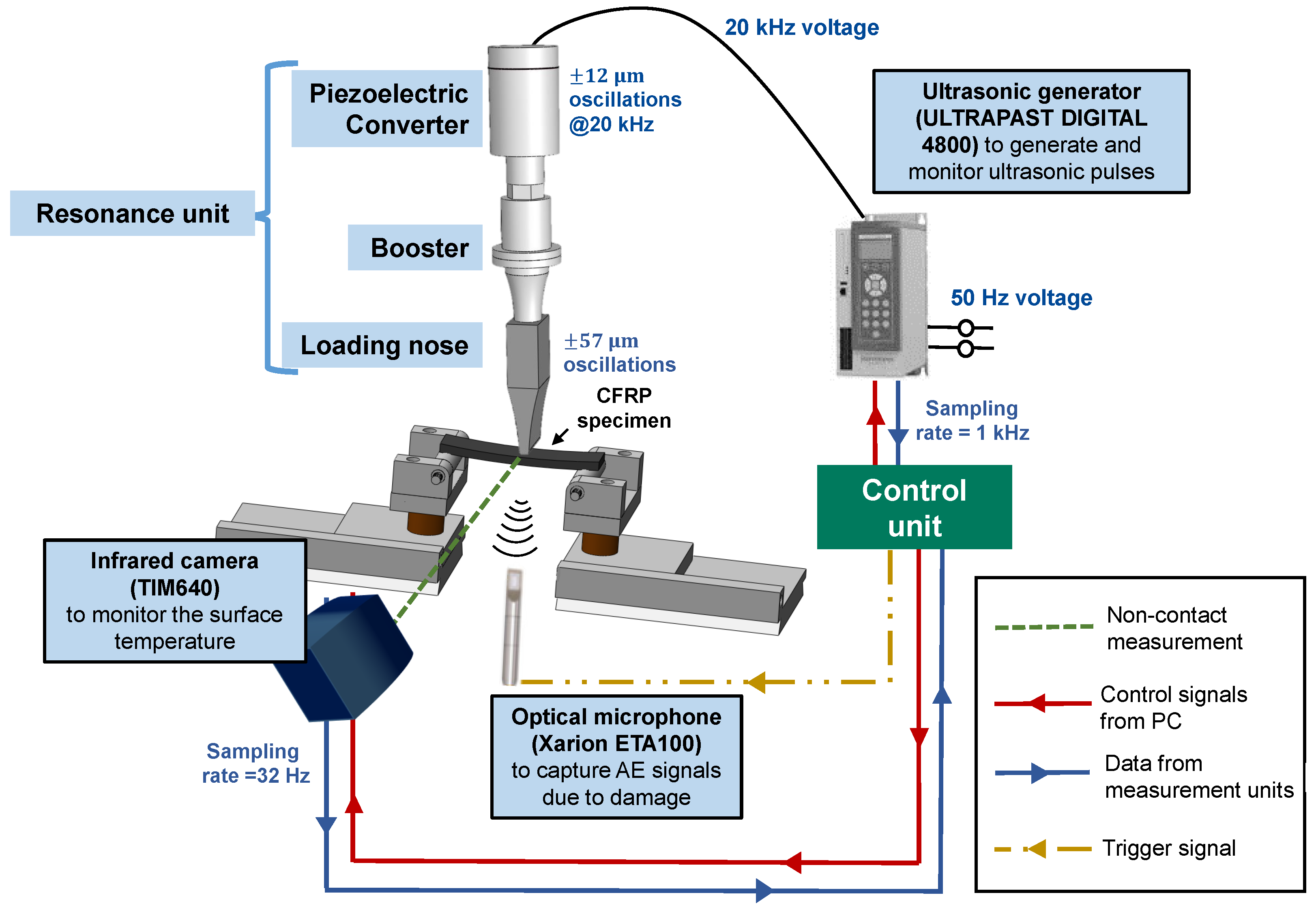


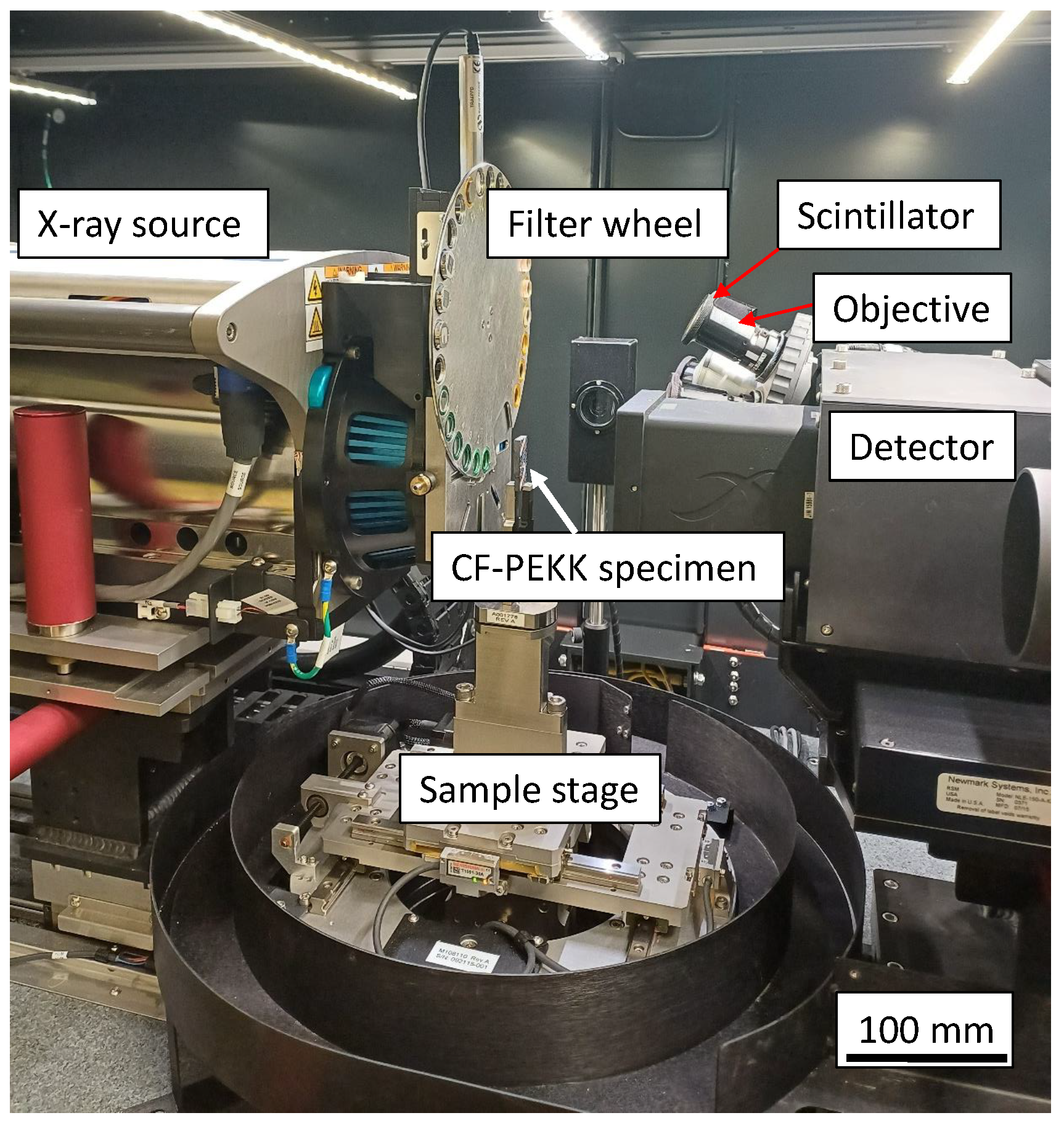




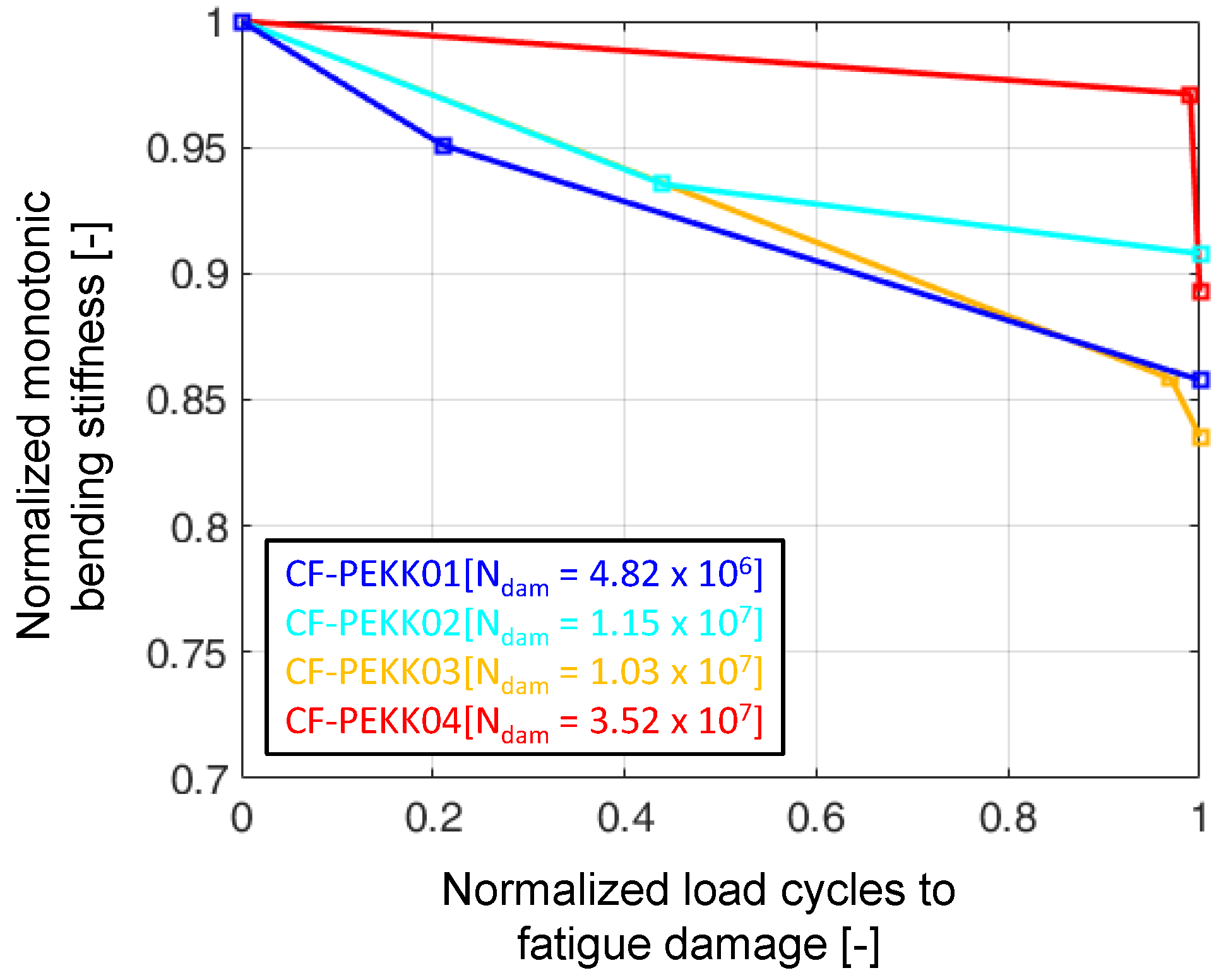




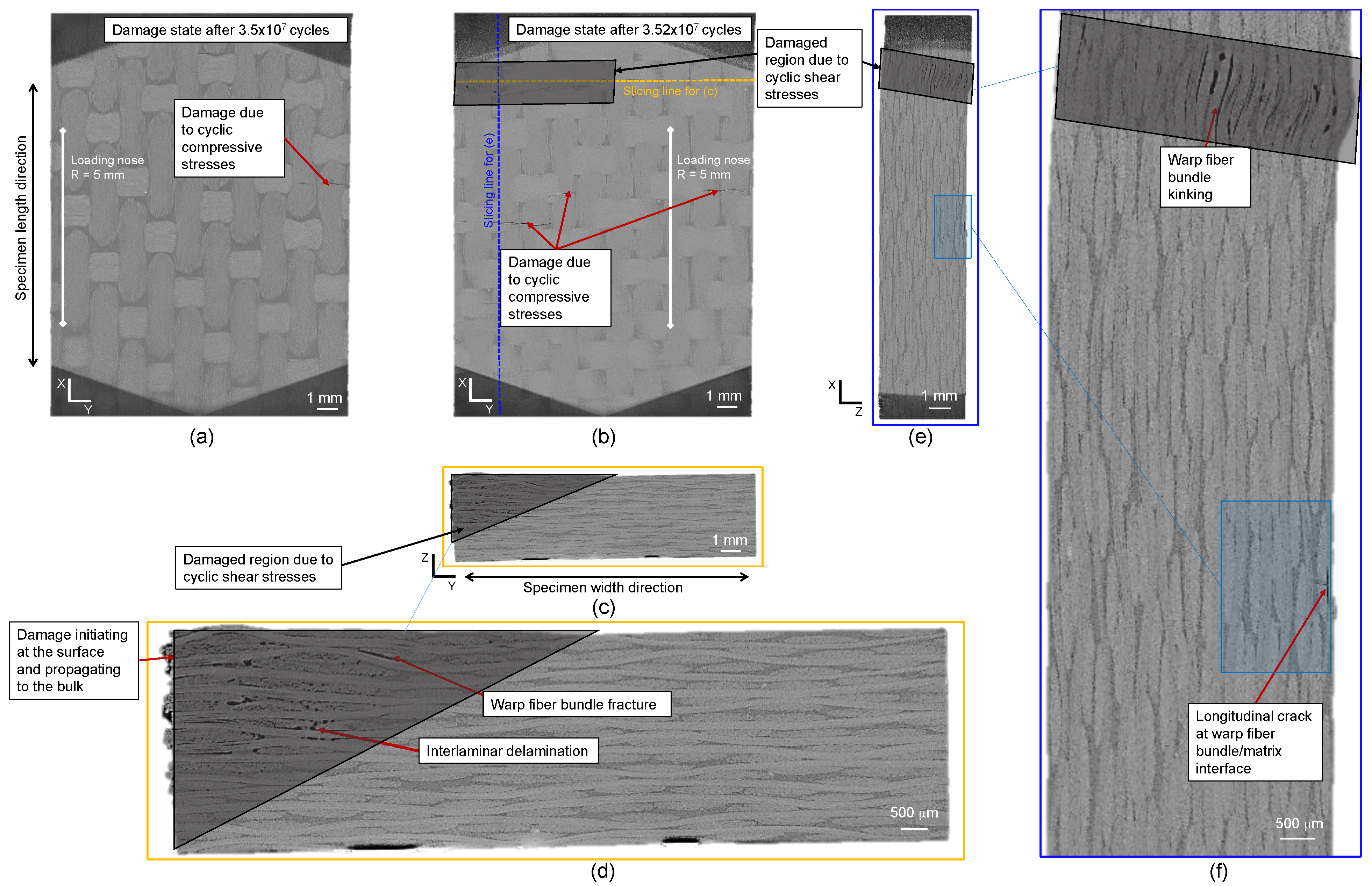
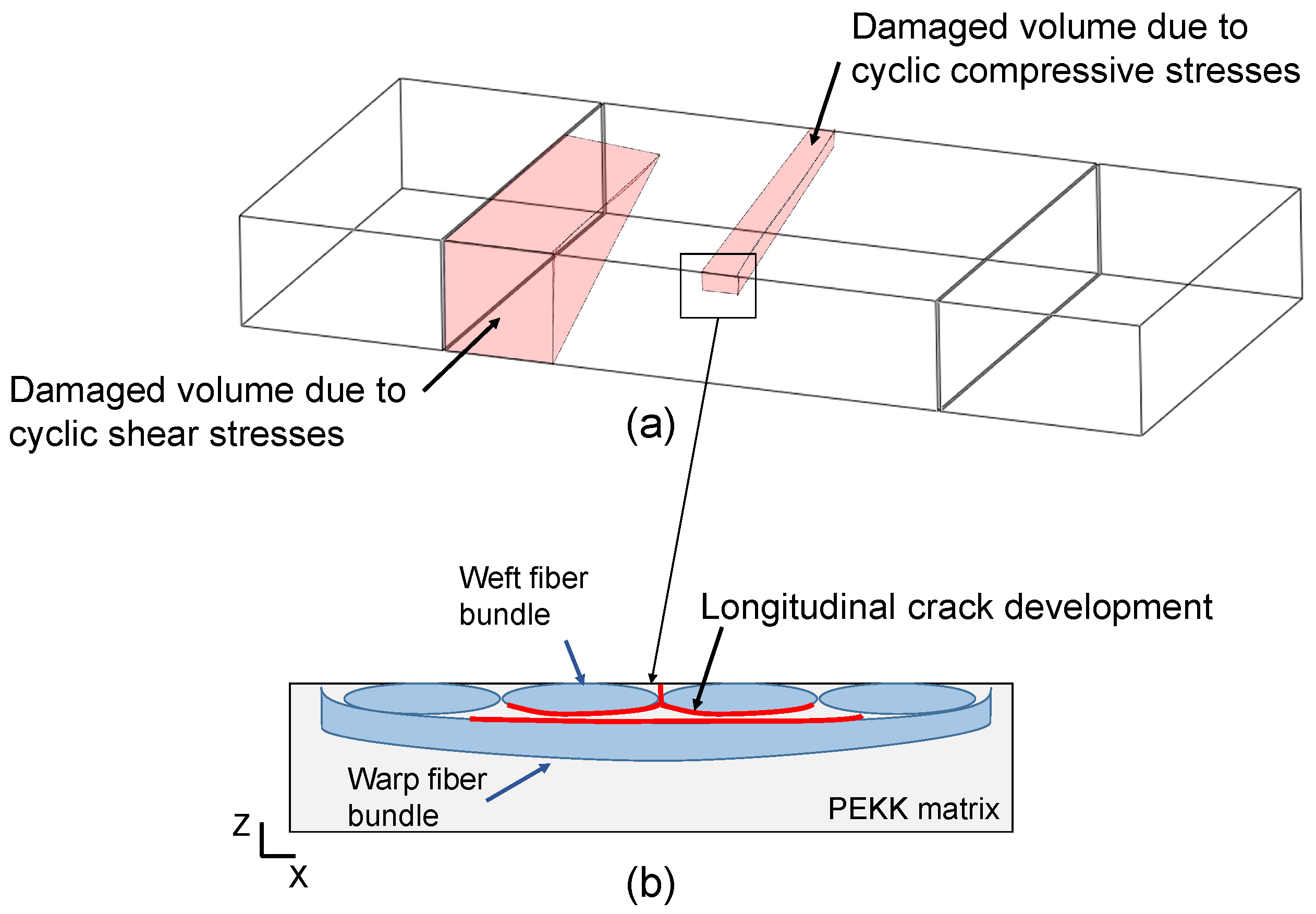
| Elastic Properties | Values |
|---|---|
| Fiber architecture | 5H satin weave fabric |
| Fiber volume fraction [%] | 50 |
| Consolidated ply thickness [mm] | 0.31 ± 0.01 |
| Number of plies [-] | 13 |
| Composite layup [-] | [0/90/0/90/0/90/0] |
| Glass transition temperature [°C] | * 160 |
| Melting temperature [°C] | * 337 |
| Tensile modulus 0° [GPa] | 58.0 |
| Ultimate tensile strength 0° [MPa] | ** 776 |
| Ultimate compressive strength 0° [MPa] | ** 585 |
| Specimen ID | |||
|---|---|---|---|
| [-] | [-] | % | |
| CF-PEKK01 | 4.82 × | 21 | |
| CF-PEKK02 | 5 × | 1.15 × | 44 |
| CF-PEKK03 | 1.03 × | 97 | |
| CF-PEKK04 | 3.5 × | 3.52 × | 99 |
Disclaimer/Publisher’s Note: The statements, opinions and data contained in all publications are solely those of the individual author(s) and contributor(s) and not of MDPI and/or the editor(s). MDPI and/or the editor(s) disclaim responsibility for any injury to people or property resulting from any ideas, methods, instructions or products referred to in the content. |
© 2024 by the authors. Licensee MDPI, Basel, Switzerland. This article is an open access article distributed under the terms and conditions of the Creative Commons Attribution (CC BY) license (https://creativecommons.org/licenses/by/4.0/).
Share and Cite
Premanand, A.; Prescher, M.; Rienks, M.; Kirste, L.; Balle, F. Online and Ex Situ Damage Characterization Techniques for Fiber-Reinforced Composites under Ultrasonic Cyclic Three-Point Bending. Polymers 2024, 16, 803. https://doi.org/10.3390/polym16060803
Premanand A, Prescher M, Rienks M, Kirste L, Balle F. Online and Ex Situ Damage Characterization Techniques for Fiber-Reinforced Composites under Ultrasonic Cyclic Three-Point Bending. Polymers. 2024; 16(6):803. https://doi.org/10.3390/polym16060803
Chicago/Turabian StylePremanand, Aravind, Mario Prescher, Michael Rienks, Lutz Kirste, and Frank Balle. 2024. "Online and Ex Situ Damage Characterization Techniques for Fiber-Reinforced Composites under Ultrasonic Cyclic Three-Point Bending" Polymers 16, no. 6: 803. https://doi.org/10.3390/polym16060803
APA StylePremanand, A., Prescher, M., Rienks, M., Kirste, L., & Balle, F. (2024). Online and Ex Situ Damage Characterization Techniques for Fiber-Reinforced Composites under Ultrasonic Cyclic Three-Point Bending. Polymers, 16(6), 803. https://doi.org/10.3390/polym16060803








